Naymans are one of the most warlike and culturally developed medieval peoples of nomadic Eurasia. Naymans along with Oirats, Keriites, Mongols, Turks participated in the ethnogenesis of many peoples of Eurasia, including Kazakhs, Karakalpaks, Uzbeks, Kyrgyz, Altaians, Nogai, Buryats, Oiratos, Kalmyks, Khazareans and other peoples. The mystery of the origin of this people is still the subject of the hottest and fiercest disputes.

Naymans in the Mongol Empire 1207.
What does the self-name Nayman mean?
On the origin of the self-name Naiman there are several versions. According to the most widespread version, the name is connected with the numeral eight in the Mongolian language, which means the Union of eight tribes. Here it is worth noting that the numbers 4 and 8 were quite often used in Mongolian chronicles, when describing other unions, which is probably related to numerology.
Another version of the name is connected with the Turkic origin, where the name Naiman is connected with the confederation of eight tribes Sigiz Oguz nomadic in the 7-8 centuries in the north of Altai.
Some researchers link the Altai river Maima near Gorno-Altaisk with the name Naiman. According to this version, the Naimans are descendants of the Altai Maima, which brings them closer to the Altai-Kizhi ethnos.
Naiman totems: golden eagle and dog
Till today there is a legend about the origin of the Naimans The ancestors of the Naimans came from distant places from Altai as a result of the fact that most of the people were destroyed by enemies. The remnants of the once powerful people were rescued and brought by a golden eagle to the mountain peaks of the golden mountains. This imposed a strict ban on golden eagle hunting.
Having preserved their warlike ways, the Naimans continued to wage fierce wars with the Chinese. The Naimans trace their ancestry back to the dog, not the wolf, as many Turkic peoples do. For this reason, they have a dog’s liver. Thus the Naimans are symbolically connected with the golden eagle and the dog, embodying two levels of patronage in their sacred origins: heavenly and earthly.
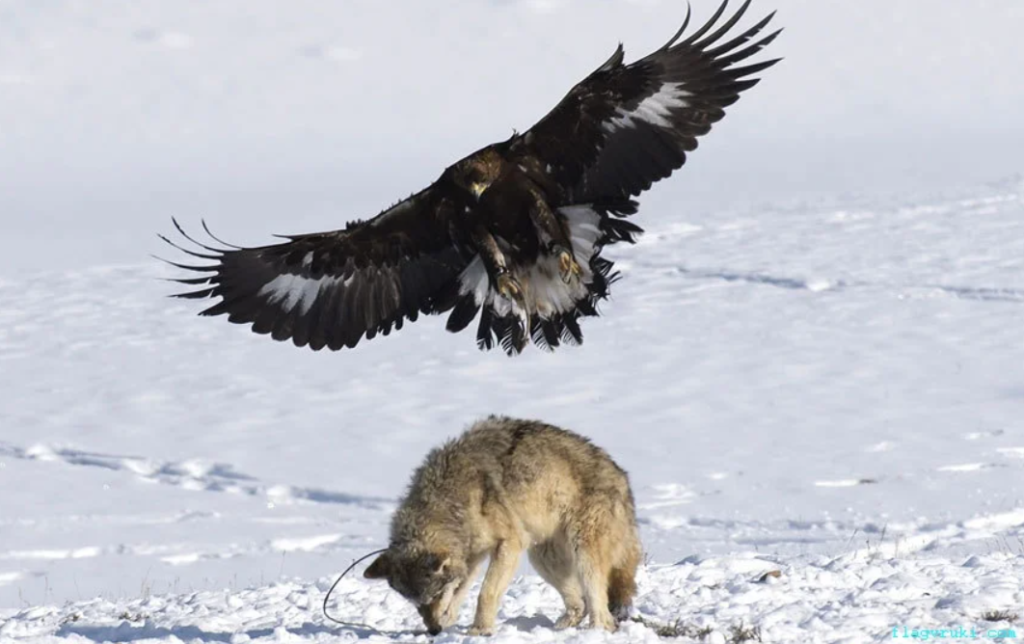
The golden eagle and the wolf
Türks or Mongols?
As for the ethnogenesis, for many years there have been debates about the origin of the Naymans. and to which ethnic group they originally belonged, so let’s dwell on this issue in more detail, all
The complexity of this research task is that the earliest stages of ethnogenesis of Naymans took place in areas from Western Mongolia to Eastern Kazakhstan, where from century to century the powerful and boundless kaganates created by formidable nomads such as the Turkic Kaganate, Eastern Turkic Kaganate, Uigur Kaganate, Kirghiz Kaganate rapidly and also suddenly descended from the historical stage.
And from the beginning of the X century to the first half of the XI century over this territory predominantly dominated the Kidans, whose state formation in the period of the highest dawn stretched from the Japanese Sea to East Turkestan.
This in turn gave rise to a whole scattering of own names and titles of the Naimans, which were of both Turkic and Mongolian origin.
In the Eurasian environment such phenomenon when titles and names easily passed from one semantic space to another is well studied. For example, the well-known Turkic title Kagan, which became widespread under the founder of the Turkic Kaganate Bumyn-Kagan (552) and his descendants, was originally recorded in the ancient Mongolian ethnos Xian Bi in Chinese sources of the II century.
Then it was adopted by Zhuzhans and after their departure from the political horizon of Eurasia it was adopted by Avars and Turks, so the presence of similar titulature and personal names does not give us the right for any conclusions about the origin of this or that ethnos, especially without taking into account ethnogenesis and socio-cultural factors.
It is worth noting that the Naiman ethnos was composed of a wide combination of Turkic-Mongolian components. It is not by chance that Lev Gumilev recorded the fact that the Naimans were dominated by Mongolian language traditions, but at the same time they used the Turkic titulary. Therefore, there is both a Turkic and Mongolian version of the origin of the Naimans.

Naimanka Sabina from Kazakhstan
According to the Turkic view of the ethnic origin of the Naimans, which is very popular among Central Asian Naimanologists, the arguments are basically summarized in the following points.
Firstly, the Naimans were part of the Turkic-speaking tribal association Segiz Oguz and they are mentioned in the runic monuments of the Uigur Kaganate.
Secondly, the influence of Old Turkic culture is well traced at the level of personal names and titles to their rulers they assigned Old Turkic throne names Buyuruk-Kagan, Kuchluk-Kagan and Inanch-Bilge-Buku-Kagan and so on.
Thirdly, on the way of Mongols’ ascendancy, as it is known, stood Naimans with whom they waged irreconcilable and fierce wars since the times of the Kidan domination and had an independent political vision on socio-cultural reorganization of the region.
According to the point of view prevailing in the Soviet and Russian historiography, the Naimans are usually attributed to Mongolian-speaking tribes. Among the historians of orientalism who adhered to this position were Bartold, Petrushevsky, Potanin and many others. The conceptual core of this view was formulated by Gumilev. The eight-tribal people were the Kidani, and the word naima means eight in Mongolian. Only proper names and cultural words have survived from the Naiman language. Both of them are most often borrowed from neighbors, but we know that when faced with Kereits and Mongols Naimans explained themselves perfectly with them, which speaks about their Mongolian-speaking.
At the same time nomads came to Altai most likely as a part of the Kidans, the companions of Yelui Dashi, the Kidan commander, emperor and gurkhan of the Western Liao state.
From the geographical position of the places occupied by the Naimans and their neighbors Kereits, one can draw a parallel between the «Segiz-Oguzes» and «Toguz-Tatars» mentioned in runic monuments, then «Western» and «Northern Tzubu», and later «Naimans» and «Kereits». According to Gumilev and Hoyt, the Tzubu were one of the three branches of the Mongolian-speaking Shiwei, along with the Kidans themselves and the eponymous Far Eastern branch of the Shiwei.
Also in favor of their greater belonging to the Mongols are some fragments of Rashid-ad-din in Jami at-tawarikh. By the way, this work is one of the first that provided historians with impressive material on the Naimans even before Genghis Khan.
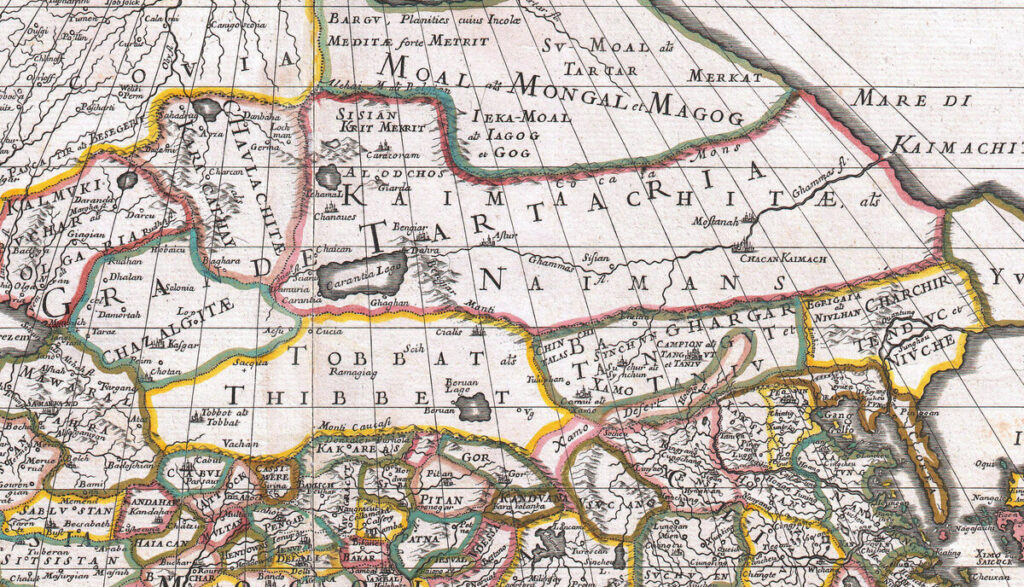
Fragment of the map of 1697, where the Naiman state is marked
The Naiman tribes were nomadic some dwelling in mountainous areas and some in the plains they had a large and good army their customs and habits were similar to those of the Mongols.
As for the Chinese sources, they also bring the Naimans closer to the Mongols and ethnoculturally refer them to the White Tatars whose closest relatives were the Mongolian tribe Tonguts, who professed Nestorianism.
There is also a third view, which assigns the Naimans an independent ethno-cultural pattern, referring them to the natives of the Altai. According to this version, the Naiman association was originally a union of Altai tribes such as Tumat, Azy, Kuchuki and others. Also in support of this point of view it is worth mentioning that the Naimans had their own writing, were engaged in agriculture and had traditions of urban life that sharply distinguished them from the majority of nomads of the north of Eurasia.
Naymans throughout a significant historical path sought to create their own distinctive state model ceaselessly defending their rights in a fierce struggle with the Mongol-speaking tribes, that is, the Naymans had their own independent ideas about the state.
Another important factor is that the Naimans had an independent linguistic tradition or significant linguistic differences from a wide range of other Mongolian linguistic dialects. For example, the same Rashid-ad-Din pointed out their dialectal differences in pronunciation. And one of the specialists in Mongolian linguistics Vladimirtsev expressed the view that the literary Mongolian language of the times of the Mongol Empire could be an ancient Naiman dialect. The Naimans were considered the most cultured of all nomadic tribes of Central Asia. They used Old Uigur writing, on the basis of which Old Mongolian writing has appeared.

Naymans taught Genghis Khan writing
Genetics of Naimans
Two haplogroups are most commonly found in the Naimans of Kazakhstan: O2a2b1 (42 %) and C2 (37 %). At the clan level, haplogroup O2a2b1 is more characteristic of the Tolegetai clan (70%), while haplogroup C2b1a2 is more common in the Saryzhomart clan (61%).
Genetically to the Naimans of Kazakhstan from Asian peoples the closest to the Uzumchins living in Inner Mongolia and in the east of Mongolia.
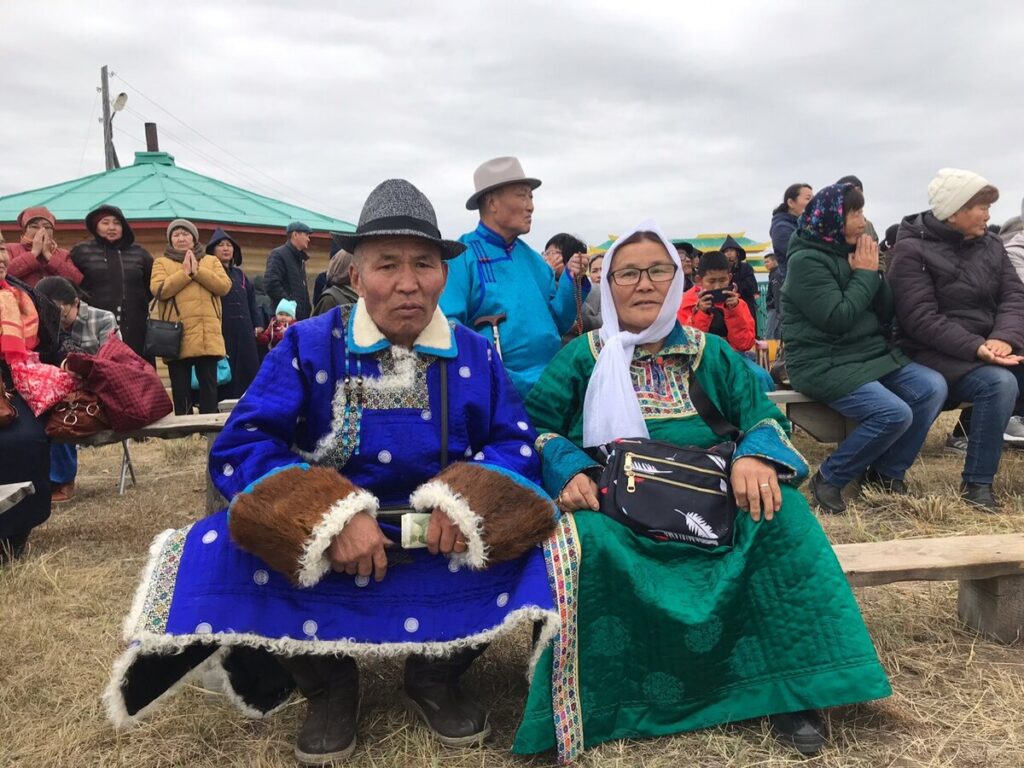
Uzumchins in Buryatia
Judging by haplogroup O, the direct ancestor of Naimans in the male line comes from East Asia. According to Sabitov, haplogroup C2 is connected with a huge array of Mongolian tribes of the XIII century, which spread this haplogroup over the territory of the Mongolian Empire.
Other haplogroups: N* (3 %), N1a1a (2 %), N1a2b (2 %), O2a2* (2 %), D (1 %), C2c1a1a1 (1 %), G1 (1 %), I* (1 %), I1 (2 %), J2* (1 %), R1a1a* (2 %), R1b1a1a2 (2 %), R1b1a1a* (1 %). Haplogroup R1b1a1a is found in the Tortkara and Baganala clans.
Naimans in the Uigur and Kirghiz Kaganates
The first historical mention of the Naymans dates back to the middle of the eighth century, when the rule over the Eurasian steppes was in the hands of the Uighurs. During this period, the Naimans also entered the political arena as a result of the bitter struggle of the Karluk, Kirghiz, Turgesh and Basmals against the Uigur Kaganate.
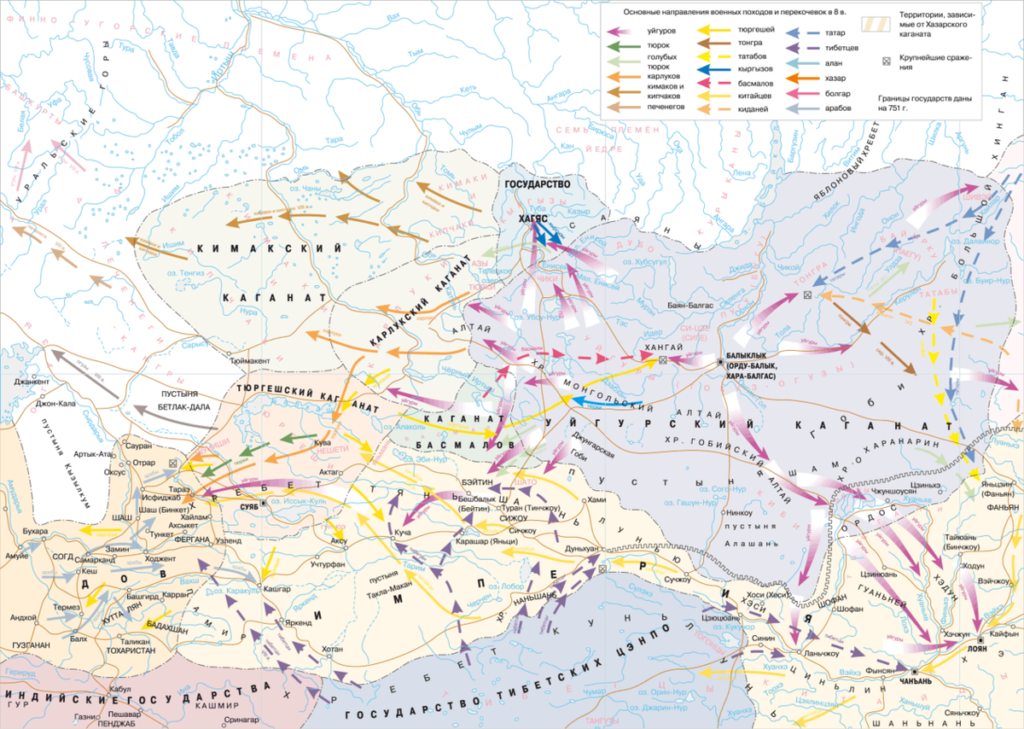
Uigur Kaganate in 751.
The Sigiz Oguzes revolt against the tyrannical policy of the Uigur ruler Moen Ur and in the struggle for the Uigur throne between Moyan-Chura and Tai Bilge-tuk Segiz Oguzes supported the latter in the dynastic turmoil.
Two armies met in a place called Byukagyuk. The battle began in the evening, while the sun was still shining the army of Bilge-tutuk was scattered, but at night they reassembled. At night the army of Bilge-tuk was left by nine tribes of Tatars and eight tribes (probably Naimans or Kidans). At sunrise on the second day, Moyan-chur defeated and captured the Uighur elders of his opponent. Moyan-chur pardoned the common people, but they soon rebelled again. As a result of the bloody struggle, part of the tribes broke away from Moyan-Chur, while the other accepted vassal dependence.

Moyan-Chur, the second Uigur Khagan, 747 — 759
After the defeat of the Uigur Khaganate in 840, the next historical phase occurred in the socio-political conditions of Kyrgyz domination.
After the Uigur Kaganate fell under the blows of the Kyrgyz in Central Asia in 840, the Kyrgyz Kaganate was elevated and the process of forming a confederation of nomads of Central Asia, known in Chinese sources under the collective name «tszubu» — nomads, began.
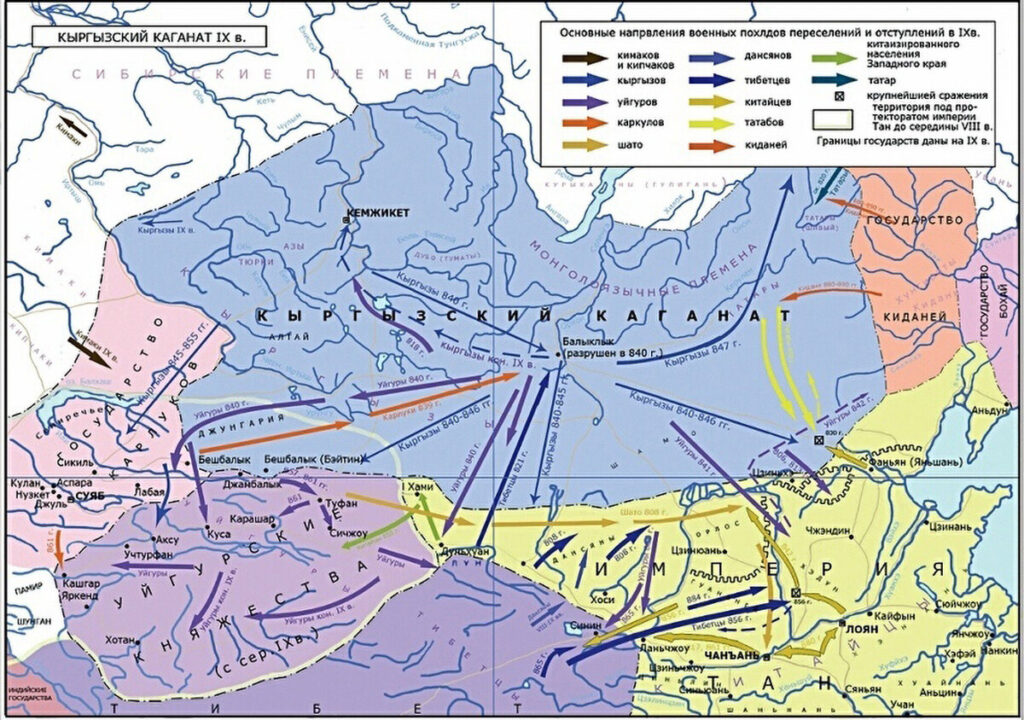
Kyrgyz Kaganate in the 9th century
Northern Tzubu were called Kereits, and western — probably Naimans. At the end of IX — beginning of X century Tzubu came into confrontation with the Kidan Liao Empire, the center of which was in Northern China. Fierce clashes in 984 led to the defeat of the Tzubu. In 1069 tszubu defeated the troops of Liao, but at the end of the XI century. steppe state again weakened. Another war was unleashed in 1092, and eventually both northern and western tszubu recognized the suzerainty of the Liao Empire.

Liao and Kara-Kidani
The ruler of the Naiman state, Inanch Khan
After the fall of the Liao state in 1125, the Naimans established their own state. In 1143, Inanch-Bilge-Buku Khan became their ruler. The Naiman state occupied lands west of the Kereits, in the Altai, Western Mongolia and Eastern Kazakhstan.

Approximate borders of the Naiman state at an early stage
For further military-political opposition to the Mongols, it for several decades fell into nominal dependence on the Kidans and in 1125 after the collapse of the Liao state, the Naimans became one of the most formidable military-political forces in the region. The Naimans had the right to act, had a widespread paperwork. Documents were sealed. Positions in the elite part of society were inherited.
From the very beginning of its existence it took a position hostile to the Kereits, challenging them for hegemony over the nomads of Central Asia. Several times Inanch-khan managed to put his protégés on the throne in the Kereite state, but after his death at the end of XII — beginning of XIII century the Naiman Khanate itself split into two parts, which were headed by two sons of Inanch — Tayan-khan and Buyuruk-khan. The split weakened the Naimans, and in 1201 both dominions were defeated by the Kereite-Mongol alliance.
In the tales of the Mongols, Inanch-khan is noted as a brave warrior and a shrewd ruler «not showing to an equal enemy neither a young man’s back nor a horse’s rear». It is also known that Inanch-khan’s favorite concubine was Tangutka Gurbesu. Here it should be noted that Naimans professed Nestorianism, and Tanguts — Buddhism, it shows religious tolerance at the court of Tanguts.

Inanch Khan and the Tangut Gurbesu.
The struggle of the Keriites, Mongols and Naimans: Wang Khan, Buyuruk Khan and Tayan Khan
The story of the Keriite Wang Khan, who constantly struggled with the Naimans, has come down to us. Once Keriit Khan was the formal leader of Mongolian tribes. It should be noted that the Keriites and Naimans practiced Nestorianism mixed with shamanism. They perceived the cross as a symbol of power over the four sides of the world — a similar cross is at the top of the yurt and is a symbol of Tengrianism. The name of Van-khan was also known in the West as the ruler of the imaginary Christian kingdom of Presbyter Ion. But because of the constant struggle of the Naimans and Keriites, Nestorianism never managed to establish itself among the Mongols.
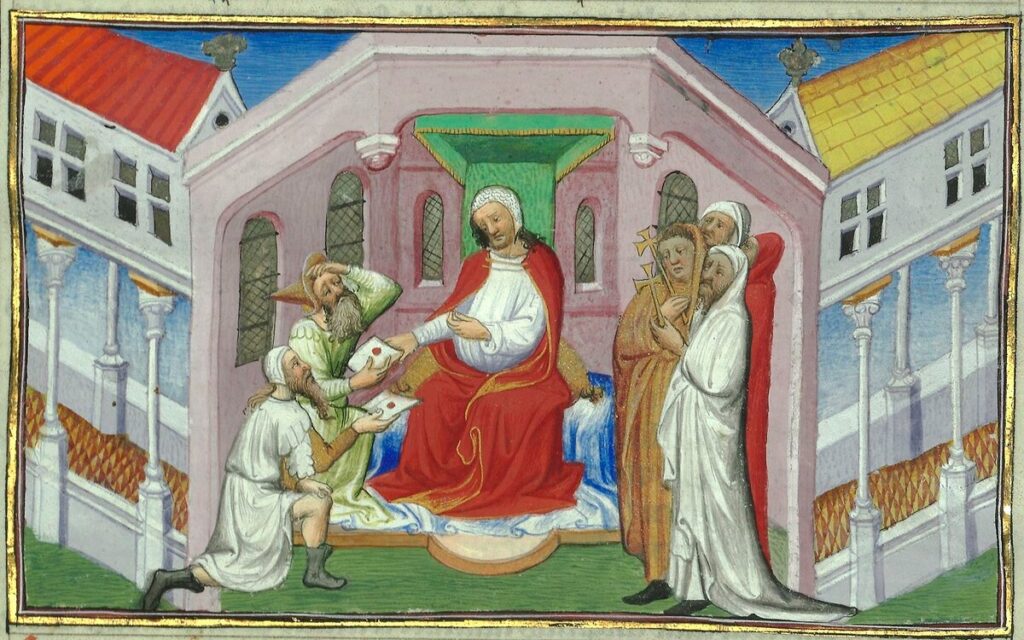
Van-khan as Presbyter John. Illustration from the late (XV century) edition of the Book of Wonders of the World by Marco Polo.
Van Khan (real name Tooril) was a twin of Yesugei, the father of Genghis Khan. Remembering this, later on Esugei’s eldest son Temujin (Genghis Khan), needing good relations with the ruler of the Kereits, presented Tooril with a luxurious sable duffel received as a dowry for his wife Borte. Friendship with Van-khan came in handy when Temujin needed to rescue Borte, captured by the Merkits. Temudgin together with Kereits and Jamukha defeated the Merkits and freed Borte.
Wang Khan fought with his brothers, one of whom fled to the Naimans and his state was unstable. He visited the Jin Empire, the State of the White Tent (Tangut), and the Karakitai Khanate several times. He sought help from the rulers of these countries against his worst enemy, the Naimans. But Jin goddikhan, Tangut burkhan and Karakitai gurkhan Zhuluhu refused to help him against Naimans, because the peace was concluded between Kara-Chinese and Naimans.
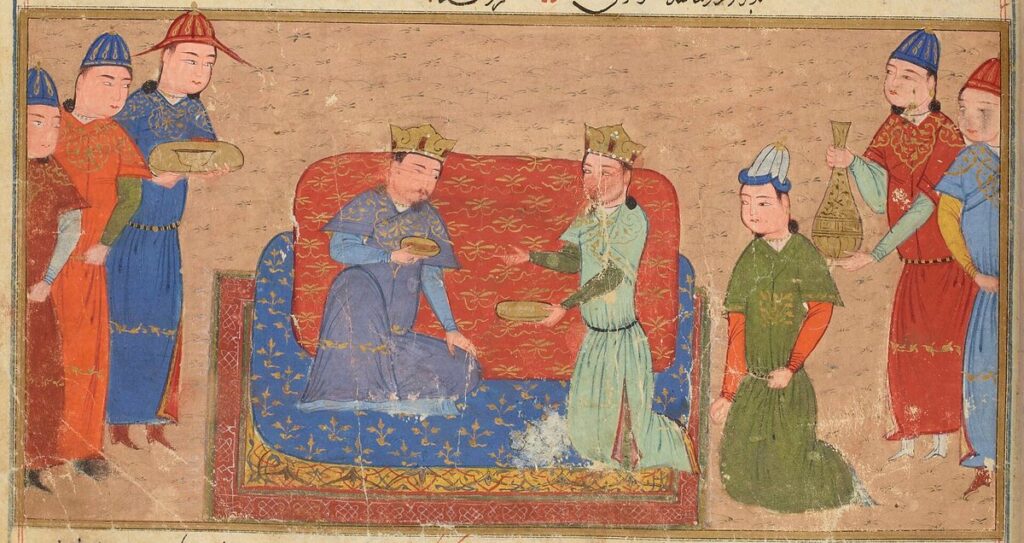
Genghis Khan and Van-Khan on a miniature from the manuscript Jami at-tawarikh (15th century)
As a result, in 1201 some Mongol tribes (Tatars, Taijiuts, Merkits, Naimans, Oirats and some others) decided to unite around Jamukha, Genghis Khan’s twin from childhood in the fight against Temujin. At the kurultai Jamukha was elected gurkhan (the title of the rulers of the neighboring Kara-Kidan Khanate, which existed in 1124-1218). According to legend, during the decisive battle in the Koyten tract, the Naiman ruler Buyuruk-khan and Khudukha-beki, who possessed shamanic abilities, decided to bring a storm upon the forces of Genghis Khan and Van-khan, but the storm unexpectedly turned against them, and because of the storm and downpour Jamukha’s allies suffered heavy losses.
In the battle at Kishilbash Lake Buyuruk was defeated, but on their return home the victors were blocked by one of the Naiman detachments under the command of commander Kokseu-Sabrakh. It was decided to fight in the morning, but at night Jamukha appeared in the camp of the Kereits and, accusing Genghis Khan of exchanging ambassadors with the Naimans, persuaded Van-khan to leave the camp, hoping for Genghis’ death at the hands of the enemy. Jamukha’s expectations were not justified, and in the morning the Naimans began to pursue not Genghis Khan, but Van-khan; his nomads were ruined, and many people and cattle were taken away.
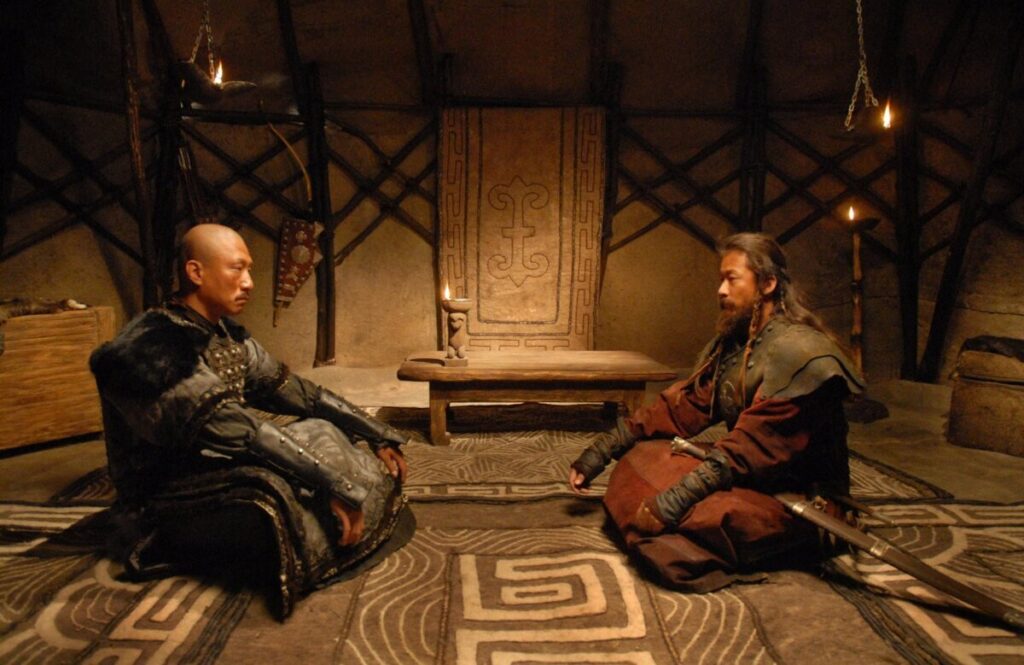
Jamukha and Genghis Khan
After this incident, Genghis Khan still wanted to maintain good relations with Van-khan and offered to be related to him. Van-khan was offered to marry Chaur-beki, daughter of his eldest son Dzhuchi, and Chinggis Khan’s daughter Khojin-begi to marry Van-khan’s son Sangum. However, the Keriites did not like the elevation of Genghis Khan, and Sangum in collusion with Jamukha decided to use the wedding as an excuse to lure Genghis Khan into a trap. But this plot was uncovered. Then the Kereites, having convened a military council, decided to attack the Mongols openly. As a result, the battle of Kharakhaljit-Elet ended in a draw, but for Genghis Khan its outcome was tantamount to defeat: the Mongol troops suffered significant losses. Some time later Genghis Khan managed to take revenge and defeat Van-khan’s camp.
Unrecognized, Van-khan was killed on the border by the Naiman noyon Khorisu-bechi. The head of the deceased was delivered to the aforementioned favorite concubine Gurbesu, now the mother of the Naiman Tayan-khan, who identified the Kereite ruler.
In the Hidden Tale of the Mongols, § 189 the following scene is given.
Gurbesu, the mother of Naiman Tayan-khan, said:
«Wang-khan was, after all, of ancient khan lineage. Let them bring his head here. If it is really him, we will make a sacrifice to it». They sent to Khoris-bechi, and he cut off and brought his head, which was recognized. They sent out a big white koshma and, having put the head on it, began to make a sacrifice before it, having folded their palms prayerfully and having made their daughters-in-law, performing the ceremony prescribed for them, sing to the sounds of the lute-hur. As suddenly the head at this sacrifice laughed, «You laugh!» — said Tayan-khan and ordered the head to be trampled to pieces with his feet. Then Kokseu-Oabrakh said: «You ordered to cut off the head of the deceased khan and bring it here; why should we trample it with our feet? It is not without reason that our dog has begun to bark. Inancha-Bilge-khan used to say:
«My wife is young, but I’ve grown old. Tayana gave birth to this one through her prayers. Ah, my son, who was born by Torluk (guardian spirit). Will you be able to rule the noble as well as the many subjects of my ulus?
It is not to the good of something herds of barking dogs. Our sovereign lady Gurbesu rules shrewdly. But you, my Khan Torluk-Tayan, you are too pampered. You have no other cares or skill but bird-hunting and animal round-ups!» Having endured these words, Tayan-khan said: «They say that there are some insignificant Mongols in the northern side and that as if they frightened the ancient Orthodox great sovereign Van-khan with their sidaks and brought him to death by their indignation. Did he, Mongol, think of becoming a khan? Does the sun and the moon exist so that both the sun and the moon shine and shine in the sky at once? It is the same on earth. How can there be two khans on earth at once? I will go and bring these, what’s their name, Mongols here!» Then his mother, Gurbesu, said: «What more could we ask for!
The Mongols’ costume is unattractive,
«They themselves stink to death.
Please stay away from them! Perhaps their women and wenches are good for milking our cows and sheep, if only we select the best of them and tell them to wash their hands and feet!» — «Well, all right! — says Tayan Khan. — Whatever these Mongols are like, we will go and bring their sidaks here.»
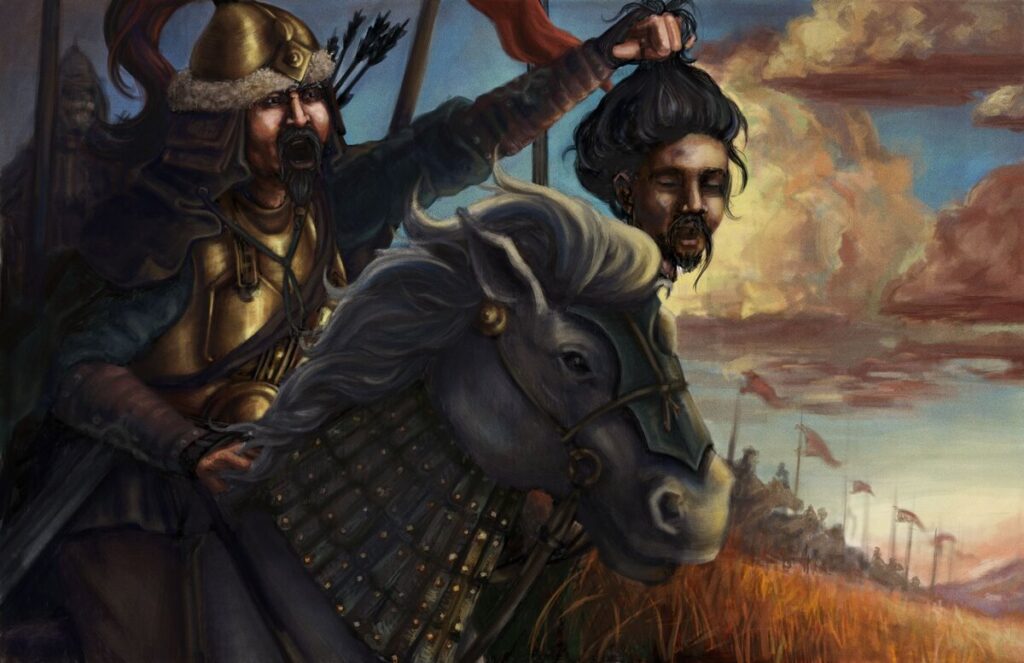
Wang-khan’s son Sangum managed to escape first to the Tangut state of Xi Xia, and then to East Turkestan, where he was soon killed by the Uighur leader Klych-Kara. Thus the ancient Kereit Khanate ceased to exist.
How fighting the Naimans led to new battle tactics
Subsequently, to subdue the Naimans and defeat Jamukha Genghis Khan developed a unique tactic known as «tumbleweed». With the new battle tactics, the Mongols could now defeat any enemy.
When the Mongol army met Tian Khan’s powerful Naimans, the Mongols behaved in an unusual way. Instead of waiting until daylight and engaging the enemy in open combat, an hour before dawn they made several attacks, pelting the enemy with clouds of arrows and rushing back.
This tactic was called tumbleweed. Its meaning was to exhaust the enemy, undermine his morale and cause damage with minimal losses to themselves.
Then Genghis Khan, taking advantage of the pre-dawn darkness, dispersed small detachments around the camp of the enemy and ordered to attack from all sides. Naymans were thus deprived of initiative and could not estimate the number of attackers. Here, too, the tactic of «tumbleweed» worked, as Genghis Khan’s troops quickly retreated back after each attack.
Having sufficiently exhausted the Naimans, Genghis Khan ordered them to form a battle order called «lake». Here is how historian J. Weatherford describes it:
«The troops stretched out in a long chain, the front row released in the enemy arrows volley and immediately moved back, giving place to the next wave. Like a surf, they rolled into the enemy positions, striking and immediately disappearing into the darkness. Those who retreated stood at the back of the column and formed a new ‘wave'».
To protect themselves from the enemy’s broad formation, the Naimans stretched out in a long chain. As soon as they did this, Genghis Khan moved on to the final part of his plan. On his orders, the troops regrouped into a battle order «awl». The Mongols lined up in a narrow but very deep formation. Thus, they concentrated the blow in one point and easily broke the stretched enemy formation.
The next morning the Mongols finished the disorganized Naimans and executed Tian Khan.
The last ruler of the Naimans was Kuchluk
Kuchluk turned out to be the last Naiman ruler who waged war with Genghis Khan for almost 20 years.
The son of Tayan-khan and the last ruler of Naimans Kuchluk together with Mirkit ruler Tokh Toki and now rescued to Ulu of his uncle Buruk khan
After the defeat of the Naimans by the troops of Temujin and the death of Tayan Khan (1204), Kuchluk went westward to the Irtysh steppes, where he united with the Merkit Khan Tokhtoa-beki, who had also fled from the Mongols. In 1205 Kuchluk and Tokhtoa were defeated by Mongols in the Irtysh valley. Kuchluk again managed to escape, this time to Semirechye, to the Gurkhan of Kara-Kidan Yelui Chulhu.

Gurkhan accepted Kuchluk and gave his daughter Tafgach-khatun for him. Nevertheless, when Khorezmshah Mohammed took away Samarkand and Bukhara from Kara-Kidan, Kuchluk did not come to the aid of Gurkhan, seized his treasury and tried to take Yelui Chulhu himself captive. However, in the battle near Balasagun Kuchluk was defeated. The army of the Gurkhan recaptured the treasury, but did not return it to the ruler. As a result of this rebellion, the Gurkhan was captured by Kuchluk in 1211. Yelui Zhulhu was left his title, but the real power in the country was held by Kuchluk.
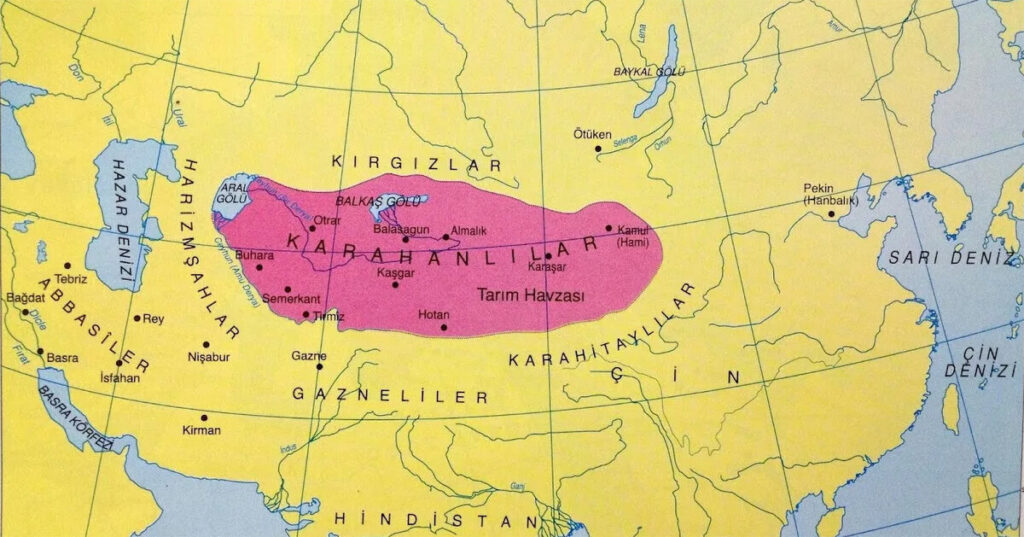
The last Naiman state
In 1213 Yelyu Zhulhu died and Kuchluk was proclaimed gurkhan. Having become the only ruler of Semirechye, Kuchluk started a war with Muslim countries. Several times he sent ambassadors to Khorezmshah Muhammad. In 1217 an embassy from Baghdad caliph Ahmad an-Nasir arrived to offer Gurkhan Kuchluk an alliance against Khorezmshah Mohammed.
Religious intolerance was ultimately the cause of Kuchluk’s defeat. Apparently he was first a Nestorian, and then under the influence of his Buddhist wife he began to «worship strange gods». As we recall, his tangutka mother Gurbesu was also a Buddhist. As a result, he launched a religious persecution against the Muslims, who constituted the majority of the state’s population. In 1218, Gurkhan besieged the city of Almalyk, whose ruler recognized the power of the Mongols. In response, Genghis Khan sent a 20,000-strong army of Dzhebe against Kuchluk. Upon entering the Kara-Kidan state, Djebe proclaimed religious freedom, and Muslims began to kill Kuchluk’s warriors who were stationed in the cities. Gurkhan fled, but was caught in the Pamir mountains near the Sarykol River and beheaded.
Thus, together with the death of Kuchluk the impressive pleiad of outstanding Naiman rulers, whose military-political efforts became an important factor in the deposition of the mighty power of his era, the Kara-Chinese Empire of Liao, and who sought to realize their state system in every possible way struggling against the emerging passionary force in the face of the Mongols at the turn of the 10th-11th centuries, comes to an end.
Contribution of the Naimans to the Mongol culture
The Naiman Khanate stretched from the Tamir and Orkhon rivers to the Irtysh. Naimans adhered to Nestorianism and had an independent written tradition on the basis of the Old Uigur script. Relations were regulated by centuries of well-established folk customs, fixed in their legal code and had a relatively complex paperwork. According to many Eurasian historians, the Naimans were the most culturally advanced people. Libraries and baths were widespread in their towns, and housing conditions were supported by running water and sewerage.
It is known that the Naiman state tradition envisioned advanced urban planning practices and integral economic models. It was the Naiman linguistic tradition that formed the basis for the Old Mongolian script.
In the ulus domains of the Chingizids, Naiman communities were widely represented in the Golden Horde and in the ulus of Chagatai. Tamerlane’s military layer was also composed of Naiman cadres. Among the Central Asian peoples, countless Naiman batyrs and outstanding political figures emerged from among the Naimans, who played an outstanding role in establishing the ethnic identity of the entire region.
As for the representation of the Naimans among the Eurasian peoples, the geography of their settlement is amazing. The descendants of the Naimans constitute one of the nationalities of the southern Mongols, the Naimans constitute a separate aimag in inner Mongolia, occupy an important place in the zhuz system of the Kazakhs, being a part of the Middle zhuz, and along with other five tribes form the ethnic core in the northeastern part of Kazakhstan.
In the Kyrgyz they have been represented since time immemorial as part of the Ichkilik branch. The Naimans appear in the textbook list of 92 Uzbek tribes that lived in the oases of the Central Asian region long before the Shaybanid migration. The Naimans are also present among the Altai clans, retaining their ancient self-name Maiman. Their communities are also represented among the Nagai, Buryats, and Hazaras.
It is also worth noting that after the weakening of the Mongol Empire, the tribe of Oirats, led by Togon Taishi and Esen Khan, began to rise, and they began to compete with the Mongol khans. Long-time opponents, Naimans, Keriites and Barguts became part of the confederation of Oirat tribes and played an important role in opposing the Mongols in the 15th-16th centuries. Later, the Oirats created three khanates: the Khoshut Khanate in Tibet, the Dzungar Khanate in southern Siberia, and the Kalmyk Khanate. Thus, the descendants of Naimans could be in all three Oirat khanates.
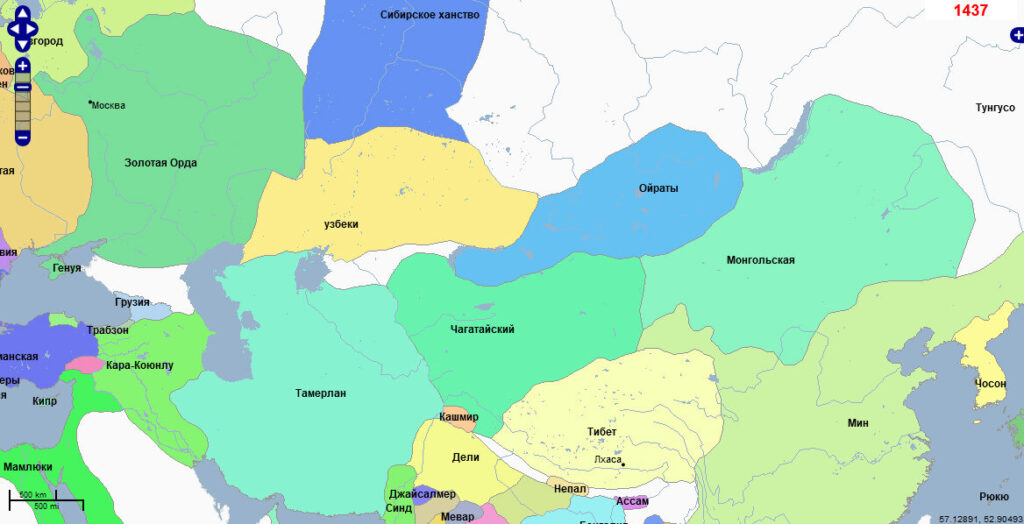
Oirats in 1437,
As history has shown, the Naimans throughout their historical journey cherished the dream and fought for the right to have their own statehood. This motivation explains their almost five hundred years of relentless struggle against various Turkic-Mongol political systems. Having barely taken the position of the leading power in the region, the Naimans soon gave way to the formidable Horde order of Genghis Khan. Perhaps this unquenchable historical impulse of statehood was realized in a different way, but already in the post-Mongolian epoch, when having become part of many Eurasian peoples, the Naimans played a prominent role both in ethnogenesis and in the formation of their independent state system.
